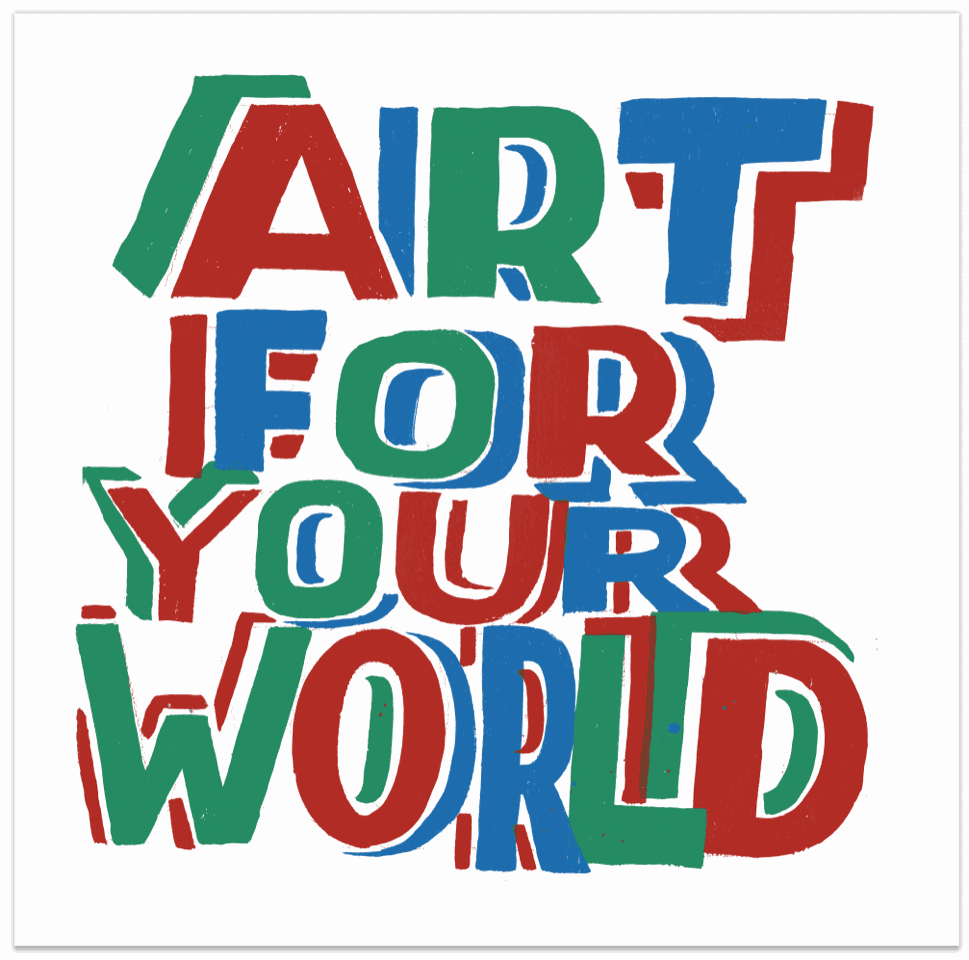
Thank you to Phin Jennings, Curator at Rise Art for the below blog focussing on the specially commissioned limited edition prints for Art For Your World. The print are available to buy via Rise Art here.
Can Art Change the World? Art, Activism and the Environment
written by Phin Jennings, Curator at Rise Art
We are proud to support WWF’s fight against the climate crisis in their latest campaign, Art For Your World. On October 20th, we will release 3 exclusive limited edition prints from internationally renowned artists Chila Kumari Singh Burman, Heather Phillipson and Bob and Roberta Smith in Support of WWF. In line with the launch, our curator Phin Jennings discusses how we as art world participants can look to our own actions to join a wider conversation about climate change.
On October 20th, we will be releasing three exclusive limited edition prints by Chila Kumari Singh Burman, Heather Phillipson and Bob and Roberta Smith in Support of WWF. The funds raised will be used to support key areas of the charity’s work that contribute to combatting dangerous climate change, such as halting deforestation, supporting communities, restoring trees and forests, replanting seagrass meadows, protecting endangered species and promoting sustainable lifestyles.
This launch is part of Art For Your World, a collaborative project led by curatorial practice Artwise. Art For Your World is a series of actions taking place this autumn in the context of the 26th UN Climate Change Conference (COP26). A wide call to artists, collectors, galleries, museums and arts organisations to make a meaningful connection between art and the environment, in order to support the groundbreaking work being carried out by WWF, one of the world’s largest conservation organisations. To coincide with this launch I wanted to look into how we can do this, both by changing our own habits and by raising awareness and resources to affect change in the wider world.

Fierceness in Scarcity, detail, 2021, by Chila Kumari Singh Burman
At Frieze London last weekend David Zwirner, an international mega-dealer, sold Kerry James Marshall’s 2021 painting Black and Part Black Birds in America: (Pigeon and Black Capped Chickadee no 2) for $2.2 million to a US-based collection. The painting was completed in Marshall’s studio in Chicago, packaged and shipped to the UK where it resided for less than a week before heading to its new home back in North America. It is with this all-too-commonly-accepted trade off - big profits for big carbon emissions – in mind that gallerist Stuart Shave commented on the In Other Words podcast that “we have to ask serious questions about the climate crisis and how accountable the art world can be.”
The art world is inefficient in many ways. As participants we waste time, money and resources to participate in traditions and follow codes of conduct that were here long before we were. If this wastage only impacted us then, with the size of the payouts at stake, then sticking to the status quo might be justified. But we should also hold ourselves accountable for its external impact: the contribution that the inefficiencies make to environmental damage. This is easier said than done. For any dealer, collector or artist it is easy to feel like an inconsequential part of a vast system that perpetuates the same behaviours regardless of our individual actions. To opt out of the wastage is to opt out of the market. Refuse to travel by plane? You’ll miss the fair. Refuse to needlessly ship your work across the world? You’ll lose your place in the booth.
 Art For Your World, 2021, by Bob and Roberta Smith
Art For Your World, 2021, by Bob and Roberta Smith
It seems like the way out of this is through organisation: collective pledges that normalise acting more conscientiously. Established in 2020, the Gallery Climate Coalition (GCC) is a group of more than 550 galleries, institutions and individuals who have made a commitment to cut their carbon emissions by 50% in the next ten years. This commitment means starting at home, making small, impactful changes to our own behaviours. Alison Tickell, founder of environmental nonprofit Julie's Bicycle, explained in an interview for the GCC that it is about asking “what can I do that’s radical but realistic?” – what small changes can I make to send clear messages? For example, Stuart Shave suggests that dealers engage in a difficult conversation with international collectors and curators planning on visiting their exhibition openings: “don’t take this the wrong way, but why don’t you not come?”
The way that it is bought and sold aside, art itself can change the world too. In the context of a resource-draining art world – even one where some are working towards change – a cynic might shrug art with an environmental message off as lip service. However, a medium as emotional and potentially captivating as visual art is a fantastic one to spread a positive message – even if our own house isn’t quite in order yet. Tickell encourages artists and galleries to “get to know the issue from your own angle.” Part of our angle (or at least that of curators, artists and exhibition-makers) is using art to capture the hearts and minds of our audience. To me, this seems like a helpful way to join the conversation about climate change.
 what the seagrass says, 2021, by Heather Phillipson
what the seagrass says, 2021, by Heather Phillipson
Artistic gestures can also be accompanied by more concrete actions. When I spoke with Bob & Roberta Smith, one of the artists who has been commissioned for the Art For Your World print launch, he mentioned this both-and potential in this project and ‘Help Art Save Lives’, another charity campaign he is involved in: “art can raise awareness of issues and if artists have particular expertise in an area they can make a difference but with #helpartsavelives I hope to push a more tangible effort.” Claire Milner, an artist whose work focuses on climate change and mass extinction, identifies the same dual potential in her own work and names it “artivism”, a practice that “sparks positive change by raising awareness and significant funds for environmental organisations.”
Art can change the world. As art world participants we can look to our own actions and customs first, but don’t need to wait until we are a shining example of environmental friendliness before using our strengths to join a wider conversation about climate change. And we might need to uninvite some people from our exhibition openings.